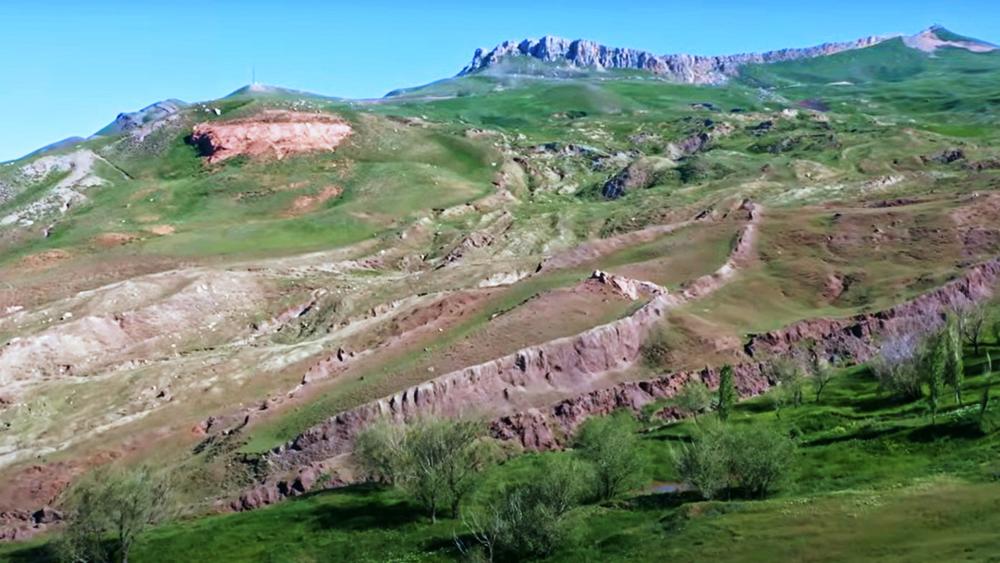Scientists excavating a large boat-shaped mound in the eastern mountains of Turkey have announced their tests on the rock and soil samples they collected at the site indicate humans were living at the site 5,000 years ago – the same time frame that some biblical scholars link to the Great Flood from the Bible's Old Testament book of Genesis.
The research team from three Turkish and American universities has been investigating the theory that the geologic formation is actually the ruins of Noah's Ark.
According to the test results, there were human activities in the region from 5,550 to 3,000 BC, according to Arkeonews. The mound exists in the Ararat region which was known as Urartu in the ancient past.
 Excavations at Durupinar formation, as the site is known, began in 2021. After receiving special permission to collect the rock and soil samples in December of 2022, tests conducted over the last year at Istanbul Technical University indicate the samples to be clayey materials, marine materials, and seafood, the outlet reported.
Excavations at Durupinar formation, as the site is known, began in 2021. After receiving special permission to collect the rock and soil samples in December of 2022, tests conducted over the last year at Istanbul Technical University indicate the samples to be clayey materials, marine materials, and seafood, the outlet reported.
"It is known that the event of Prophet Noah's flood dates back approximately 5,000 years from today. In terms of dating, it is stated that there was human activity in this region. This was revealed in the laboratory results. However, with the dating, it is not possible to definitively say that the ship was here," Prof. Dr. Faruk Kaya, the Vice Rector of Ağrı İbrahim Çeçen University told Arkeonews.
"Extensive research is needed for this to be established. In the coming period, we have reached an agreement to collaborate on joint research led by Istanbul Technical University, Andrew University, and Ağrı İbrahim Çeçen University. In the future, these three universities will come together and establish new commissions to continue their work in this field," Kaya added.
The site of the formation located in the Doğubayazıt district of Ağrı wasn't discovered until 1956, according to The Daily Mail.
But the possibility that the site is the remains of Noah's boat has detractors too. According to the outlet, Dr. Andrew Snelling, Ph.D., a young Earth creationist from the University of Sydney previously said that Mount Ararat could not be the ark's location because the mountain did not form until after the flood waters receded.
According to the Bible, the Great Flood lasted 150 days, covering the entire Earth and drowning everything except Noah and his family on the wooden ship they built, along with their precious cargo of two of every kind of animal. Genesis also records where the large boat landed.
"And on the seventeenth day of the seventh month the ark came to rest on the mountains of Ararat." – Genesis 8:4
The book of Genesis also reveals Noah received specific instructions from God for the ark's dimensions – 300 cubits long, 50 cubits wide, and 30 cubits high. A cubit is an ancient unit of length, the distance from the elbow to the middle finger, or around 18 inches long. The Ark Encounter, the sister attraction of the Creation Museum located in Williamstown, Kentucky, translated the length into modern measurements when building its replica ark at 510 feet long, 85 feet wide, and 51 feet high.
The Durupinar formation where scientists conducted their tests is 538 feet long, according to The New York Post.
Several researchers have noted the ark wasn't built as a ship that was intended to be sailed, rather it was built more like a barge, intended to protect its occupants and to float on the water.
The ark was to be made of gopher wood and was sealed with a pitch-like tar to keep the wood watertight. In 2014, Smithsonian Magazine reported four physics graduate students at the University of Leicester published their research in a peer-reviewed student publication, the Journal of Physics Special Topics, that concluded the ark would have floated.
The story of Noah's Ark is referenced in Christianity, Judaism, and Islam. Several early historians also wrote about the ark and mentioned people even seeing it, including Roman Jewish historian Josephus.
"{T}he Armenians call this place,. . . The Place of Descent; for the ark being saved in that place, its remains are shown there by the inhabitants to this day," he wrote.
Even though people in modern times have searched for the actual remains of the ark in the Ararat region of Turkey for almost 150 years, no traces of it have been officially verified. But some searchers have claimed to have found pieces of it. According to National Geographic, British attorney and politician James Bryce climbed Mount Ararat and claimed he found a piece of wood that "suits all the requirements" for being a piece of the ark.
One of the most notable searchers looking for the ark was former NASA astronaut James Irwin, a born-again Christian who, beginning in 1973, led several expeditions to Mount Ararat in order to find the remains of the vessel.
***Please sign up for CBN Newsletters and download the CBN News app to ensure you keep receiving the latest news.***
According to the Ark Encounter, there have been other popular sightings of the ark on other mountains, including Mount Suleman in Iran, and Mount Cudi or Judi. Judi in Arabic can also mean "the heights" and not naming a specific mountain at all, according to the website NoahsArkSearch.com.
The search for Noah's vessel became popularized in 1976 in the U.S. when Sunn Classic Pictures, a film company that produced family films, released the documentary In Search of Noah's Ark based on the book by David W. Balsiger. It was the ninth highest-grossing film in the U.S. that year. The documentary is available to watch online.
Due to the documentary's popularity, several books about the search for the ark followed.
Meanwhile, other explorers have claimed to have uncovered Noah's Ark, but their discoveries have always been hard to prove. CBN News reported a decade ago about one such team. You can watch that report below:
Did you know?
God is everywhere—even in the news. That’s why we view every news story through the lens of faith. We are committed to delivering quality independent Christian journalism you can trust. But it takes a lot of hard work, time, and money to do what we do. Help us continue to be a voice for truth in the media by supporting CBN News for as little as $1.











 Support CBN News
Support CBN News







